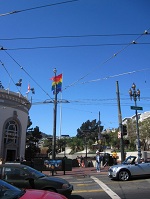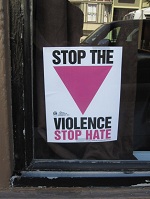Katrin Köppert
 The following observations are based on the first impressions and materials gathered by Susanne Regener on her visit to Los Angeles and San Francisco, which was made in preparation for the research trip to the United States in 2011.
The following observations are based on the first impressions and materials gathered by Susanne Regener on her visit to Los Angeles and San Francisco, which was made in preparation for the research trip to the United States in 2011.
A cartographic representation of San Francisco shows how the topography and geological characteristics of the bay area and the surrounding hilly landscape make this a very interesting location in terms of the notion of a queer architecture. The cityscape is defined by the lack of straight lines and clear lines of sight. Images of hidden corners and dark alleyways appear before our mind’s eye, conjuring up scenes of secret encounters taking place in public places (Mooshammer 2005). Cruising as a gay practice that is firmly embedded within the urban environment also evokes the changeable and circulatory nature of queer theory. At the same time, the spatial structure of these districts, which are almost separated from one another by steeply sloping streets and hills, contributes to the creation of concentrated areas through sexually motivated migration (Rubin 1984). The Castro embodies this kind of organization of homosexuals into localized populations which attempts to assert itself by means of visible symbols such as the rainbow flag – also in order to prevent moral panic (Cohen 1972, Hall 1978, Rubin 2003) over the threat of homophobic attacks in the neighbourhood. The rainbow flag helps to define and represent the district, and is also intended to strengthen confidence within the community itself.
 Tying in with such reflections upon private life and the public sphere, at the time of Susanne Regener’s visit ONE Archives Gallery & Museum in Los Angeles was showing the exhibition “Out of the Closet & Into the Street”, organized by the Center for the Study of Political Graphics. This poster exhibition not only documented LGBTQ struggles and celebrations but also showed how a community that traditionally met in bars, clubs, cottages and bathhouses moved out into the street as a site of public protest. This recoding of the public sphere and the closet (Sedgwick 2003) with respect to political issues was not only supported but actually determined by graphic art and statements printed on posters. The scream of protest that illustrated the brochure to accompany the exhibition simultaneously raises the question of how the emotions and strong personal desires which at that time motivated people to protest against and politicize a deplorable state of affairs, could have become buried to the extent that today’s slogans (“Stop the Violence Stop Hate”) and symbols (the rainbow flag) are virtually empty signifiers. In her 2007 performance, the artist Sharon Hayes accurately observed: “I March In The Parade Of Liberty, But As Long As I Love You I’m Not Free”.
Tying in with such reflections upon private life and the public sphere, at the time of Susanne Regener’s visit ONE Archives Gallery & Museum in Los Angeles was showing the exhibition “Out of the Closet & Into the Street”, organized by the Center for the Study of Political Graphics. This poster exhibition not only documented LGBTQ struggles and celebrations but also showed how a community that traditionally met in bars, clubs, cottages and bathhouses moved out into the street as a site of public protest. This recoding of the public sphere and the closet (Sedgwick 2003) with respect to political issues was not only supported but actually determined by graphic art and statements printed on posters. The scream of protest that illustrated the brochure to accompany the exhibition simultaneously raises the question of how the emotions and strong personal desires which at that time motivated people to protest against and politicize a deplorable state of affairs, could have become buried to the extent that today’s slogans (“Stop the Violence Stop Hate”) and symbols (the rainbow flag) are virtually empty signifiers. In her 2007 performance, the artist Sharon Hayes accurately observed: “I March In The Parade Of Liberty, But As Long As I Love You I’m Not Free”.
 Changes are nevertheless taking place within the realm of desire. In connection with Leather Week and the 27th Folsom Street Fair in San Francisco in September 2010, Gayle Rubin notes in the Bay Area Reporter that the boundaries of the leather community have shifted to the extent that leather is no longer only associated with gay masculinity, but now also includes women and heterosexual males. Does this perhaps mean that sexuality and desire have greater political potential than chanting catchy slogans in public? This is what Matt Baume appears to be suggesting in the title of his article “Politics and leather a natural alliance in SF”, published in the Bay Area Reporter on 23 September 2010.
Changes are nevertheless taking place within the realm of desire. In connection with Leather Week and the 27th Folsom Street Fair in San Francisco in September 2010, Gayle Rubin notes in the Bay Area Reporter that the boundaries of the leather community have shifted to the extent that leather is no longer only associated with gay masculinity, but now also includes women and heterosexual males. Does this perhaps mean that sexuality and desire have greater political potential than chanting catchy slogans in public? This is what Matt Baume appears to be suggesting in the title of his article “Politics and leather a natural alliance in SF”, published in the Bay Area Reporter on 23 September 2010.
![]() It will therefore be very interesting to see what particular stances and visualizations the museum of the GLBT History Society will have to offer when it opens on 10 December 2011. Besides the GLBT History Society, in February/March 2011 we will visit the James C. Hormel Gay & Lesbian Center, where the exhibition “Celebrating Fabulous/Activist Bay Area Lesbians with Disabilities” opened in September 2010.
It will therefore be very interesting to see what particular stances and visualizations the museum of the GLBT History Society will have to offer when it opens on 10 December 2011. Besides the GLBT History Society, in February/March 2011 we will visit the James C. Hormel Gay & Lesbian Center, where the exhibition “Celebrating Fabulous/Activist Bay Area Lesbians with Disabilities” opened in September 2010.
Cohen, Stanley (1972): Folk Devils and Moral Panics, London: Routledge.
Hall, Stuart, et al. (1978): Policing the Crisis: Mugging, the State and Law and Order, London: Macmillan.
Mooshammer, Helge (2005): Cruising. Architektur, Psychoanalyse und Queer Cultures, Vienna: Böhlau.
Rubin, Gayle S. (1984): ‘Thinking Sex: Notes for a Radical Theory of the Politics of Sexuality’, in Abelove, Henry, et al. (eds.): The Lesbian and Gay Studies Reader, New York: Routledge, pp. 3–44.
Sedgwick, Eve Kosofsky (1990): Epistemology of the Closet, Berkeley: University of California Press.
